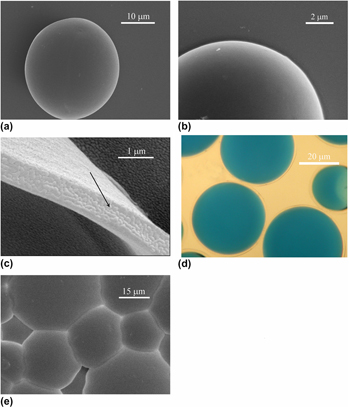Crossref Citations
This article has been cited by the following publications. This list is generated based on data provided by
Crossref.
Yin, Pei-Pei
Wu, Gang
Dai, Run-Ying
Qin, Wen-Long
Wang, Mang
and
Chen, Hong-Zheng
2012.
Fine encapsulation of dual-particle electronic ink by incorporating block copolymer for electrophoretic display application.
Journal of Colloid and Interface Science,
Vol. 388,
Issue. 1,
p.
67.
Fan, Chuanjie
Tang, Juntao
and
Zhou, Xiaodong
2013.
Role of ammonium chloride in preparing poly(urea‐formaldehyde) microcapsules using one‐step method.
Journal of Applied Polymer Science,
Vol. 129,
Issue. 5,
p.
2848.
Yin, Peipei
Wu, Gang
Qin, Wenlong
Chen, Xiaoqiang
Wang, Mang
and
Chen, Hongzheng
2013.
CYM and RGB colored electronic inks based on silica-coated organic pigments for full-color electrophoretic displays.
J. Mater. Chem. C,
Vol. 1,
Issue. 4,
p.
843.
Kim, Joo Yeon
Oh, Ji-Young
and
Suh, Kyung-Soo
2014.
Voltage switchable surface-modified carbon black nanoparticles for dual-particle electrophoretic displays.
Carbon,
Vol. 66,
Issue. ,
p.
361.
Kang, Sen
Jones, Amanda R.
Moore, Jeffrey S.
White, Scott R.
and
Sottos, Nancy R.
2014.
Microencapsulated Carbon Black Suspensions for Restoration of Electrical Conductivity.
Advanced Functional Materials,
Vol. 24,
Issue. 20,
p.
2947.
Fang, Yi
Wang, Shirong
Xiao, Yin
and
Li, Xianggao
2014.
Preparation and properties of red inorganic hollow nanospheres for electrophoretic display.
Applied Surface Science,
Vol. 317,
Issue. ,
p.
319.
Lee, Kang Uk
Kim, Myung Jun
Park, Kyung Ju
Kim, Myeongho
and
Kim, Jae Jeong
2015.
Mobility of black pigments for electrophoretic display depending on the characteristics of carbon sphere.
Dyes and Pigments,
Vol. 121,
Issue. ,
p.
276.
Yu, Fengyang
Fang, Yi
Wang, Jingjing
Xu, Yanling
and
Shi, Jun
2016.
Fabrication of compact poly(methyl methacrylate-co-butyl methacrylate-co-acrylic acid) microcapsules for electrophoretic displays by using emulsion droplets as templates.
Colloid and Polymer Science,
Vol. 294,
Issue. 8,
p.
1359.
Cui, Yue
2016.
Engineered phages for electronics.
Biosensors and Bioelectronics,
Vol. 85,
Issue. ,
p.
964.
Pang, Yuxia
Li, Xin
Wang, Shengwen
Qiu, Xueqing
Yang, Dongjie
and
Lou, Hongming
2018.
Lignin-polyurea microcapsules with anti-photolysis and sustained-release performances synthesized via pickering emulsion template.
Reactive and Functional Polymers,
Vol. 123,
Issue. ,
p.
115.
Kholghi Eshkalak, Saeideh
Khatibzadeh, Marziyeh
Kowsari, Elaheh
Chinnappan, Amutha
Jayathilaka, W.A.D.M.
and
Ramakrishna, Seeram
2019.
Overview of electronic ink and methods of production for use in electronic displays.
Optics & Laser Technology,
Vol. 117,
Issue. ,
p.
38.
Li, HongYan
Li, Qi
Liu, HongLi
Cao, Kai
Zhang, PengYu
Liu, Tong
Wang, DongMei
Liao, XiaoLan
and
Wei, DongQing
2020.
Fabrication of anti-icing surface with halloysite spherical microcapsule.
Journal of Materials Research,
Vol. 35,
Issue. 21,
p.
2887.
Park, Young‐Geun
Jang, Jiuk
Kim, Hyobeom
Hwang, Jae Chul
Kwon, Yong Won
and
Park, Jang‐Ung
2022.
Self‐Healable, Recyclable Anisotropic Conductive Films of Liquid Metal‐Gelatin Hybrids for Soft Electronics.
Advanced Electronic Materials,
Vol. 8,
Issue. 4,
Liu, Guangyou
Wu, Xinzao
Xiong, Feng
Yang, Jinglan
Zhou, Tao
Fan, Qitian
Liu, Jie
Li, Zhuohang
Zeng, Zheng
Liu, Yunhe
and
Yang, Bo-Ru
2023.
Dual-silane coupling agents co-grafted on black particles for fast response and high contrast ratio electrophoretic display.
Dyes and Pigments,
Vol. 220,
Issue. ,
p.
111692.





